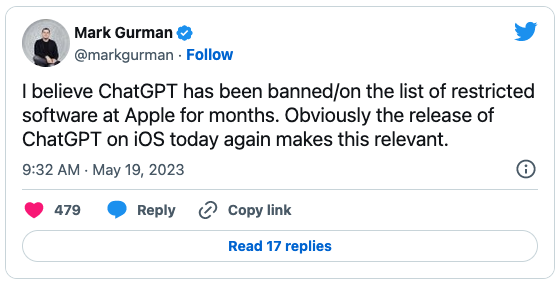
5-20 #GettingOlder : MediaTek is expected to integrate an Nvidia GPU into its SoC; Samsung Display has acquired micro-LED maker eMagin; Vodafone would cut 11,000 jobs over 3 years; etc.

Apple is testing an M3 chipset with a 12-core processor and 18-core GPU, according to Bloomberg’s Mark Gurman. He speculates the M3 variant Apple is testing is the base-level M3 Pro the company plans to release sometime in 2023. The M3 line is expected to take advantage of TSMC’s forthcoming 3nm node process. The M3 Pro reportedly features 50% more CPU cores than its first-generation predecessor. (Engadget, Bloomberg)
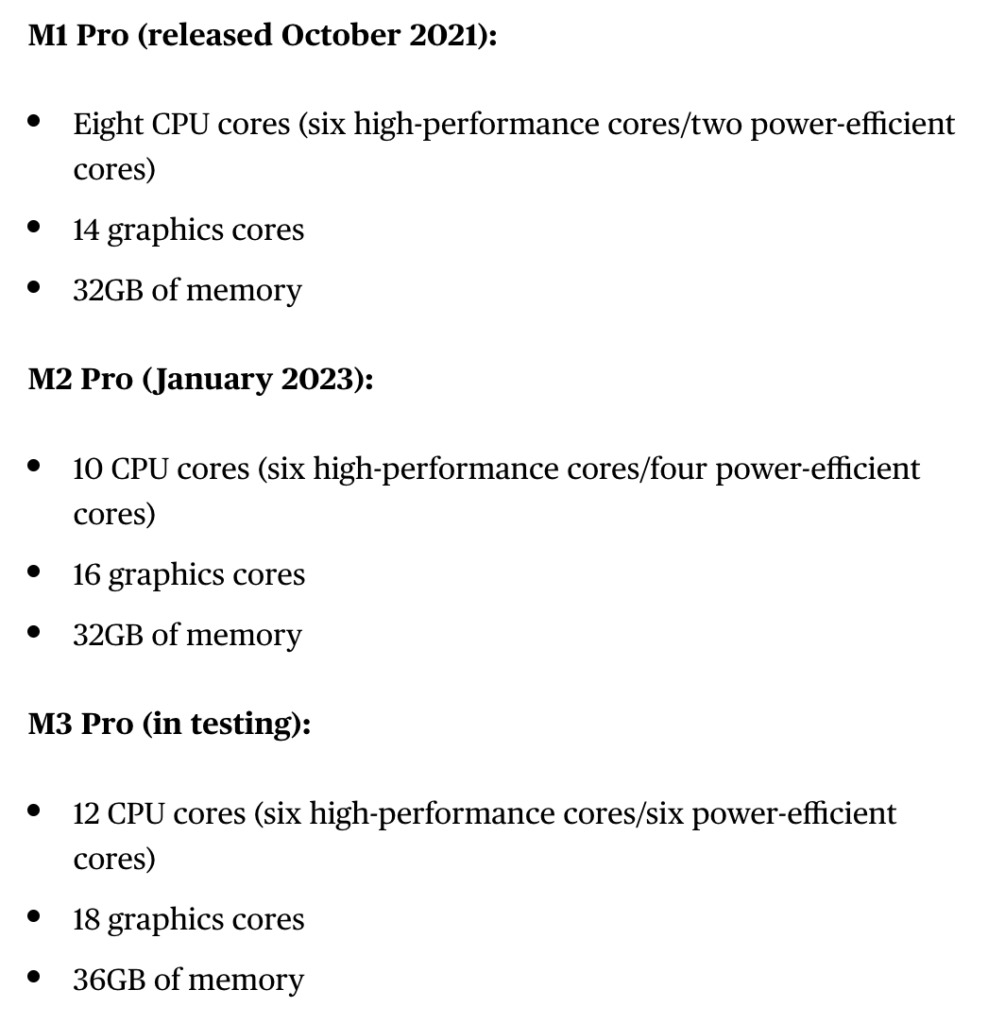
MediaTek is expected to integrate an Nvidia GPU into its next-generation flagship mobile processor as early as 2024, according to Digitimes. In addition to co-developing mobile handset platforms to enhance AI and gaming functionalities of MediaTek’s application processors, MediaTek and Nvidia will also cooperate in developing WOA (Windows on Arm) platform products for notebook applications. TSMC has continued to secure follow-up foundry orders for Nvidia’s A100 / H100 and A800 / H800 chips, which enable it to fully utilize its 7 / 5nm production capacity starting 3Q23. Meanwhile, Nvidia has also booked CoWoS packaging capacity at TSMC. Samsung has partnered with AMD on the GPUs for its chipsets. (Digitimes, Android Headlines, GSM Arena, Tom’s Hardware)
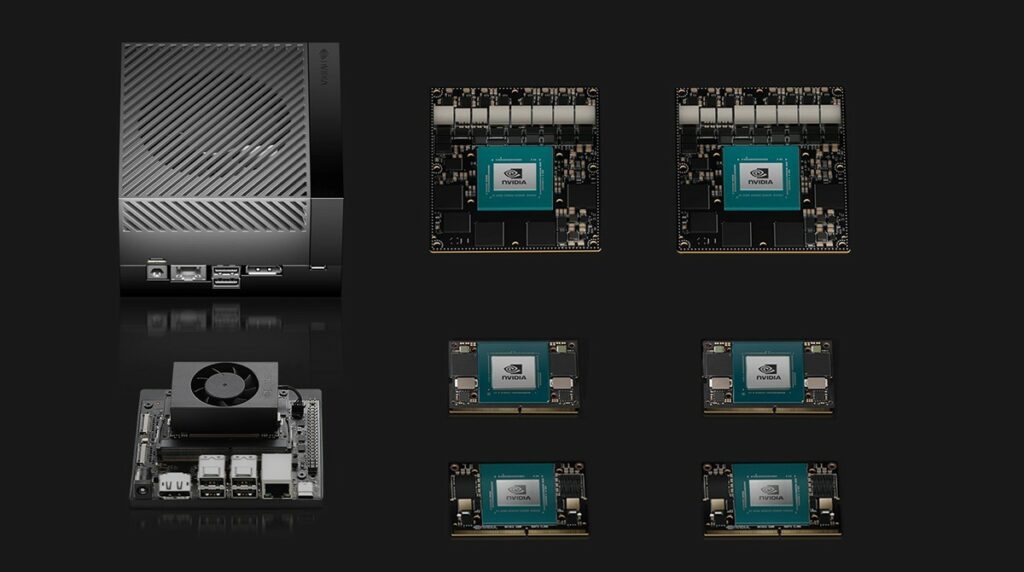
Qualcomm Snapdragon 8 Gen 4 will reportedly be made using TSMC’s 3nm (N3E) process, while the Snapdragon 8 Gen 4 For Galaxy will be fabricated using Samsung Foundry’s 3nm GAP (3GAP) process. (Android Headlines, Twitter, SamMobile)
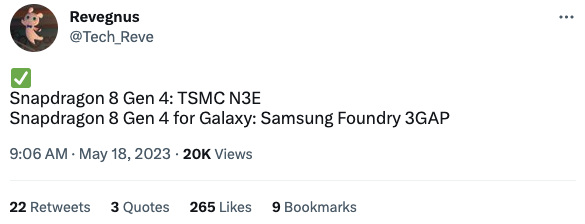
Meta is building its first custom chip specifically for running AI models. Meta’s new MTIA chip, which stands for Meta Training and Inference Accelerator, is its “in-house, custom accelerator chip family targeting inference workloads”, according to Meta VP and head of infrastructure Santosh Janardhan. With a combination of MTIA chips and GPUs, Janardhan said that Meta believes “we will deliver better performance, decreased latency, and greater efficiency for each workload”. The chip is not set to come out until 2025. In addition to the MTIA, Meta is also introducing a new ASIC specifically to help with video transcoding, which it calls the “MSVP”, or Meta Scalable Video Processor. Meta is also working on a “next-generation data center design” that will be “AI-optimized” and “faster and more cost-effective to build”. The company has also touted the power of its Research SuperCluster (RSC) AI Supercomputer.(ZDNet, The Verge, TechCrunch, Facebook)
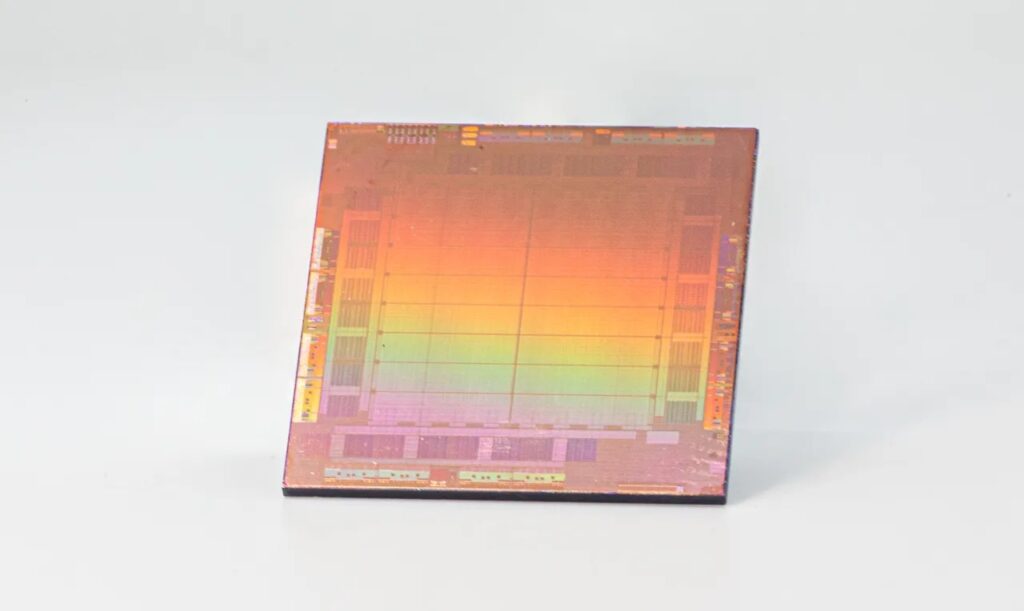
Huawei enterprise and industry semiconductor and chipset solutions including Ascend, Kunpeng, Tiangang, and Balong are reportedly making an appearance in 2H23. Since its establishment in 2004, HiSilicon has established a complete chip product system, including SoC chips (Kirin series), AI chips (Ascend series), server chips (Kunpeng series), 5G communication chips (Balong, Tiangang series) ), router chips, NB-IoT chips, and even IPC video codec and image signal processing chips, etc. (GizChina, Huawei Central, EET-China, 21ic)
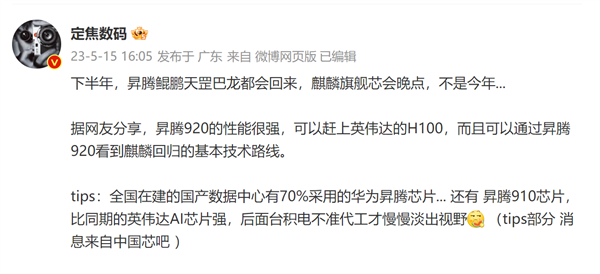
Huawei will allegedly launch its 2nd Gen Kirin A2 chip in 3Q23 / 4Q23 after 4 years out. The Kirin A1 was released in 2019 and it was first used in Huawei FreeBuds 3 true wireless Bluetooth headset, Huawei Watch GT 2 and other products. The Huawei Kirin A1 chip is the first wearable chip that supports wireless earphones, headbands, neckbands, smart speakers, smart eyewear, and smartwatches. (GizChina, Huawei Central, QQ)
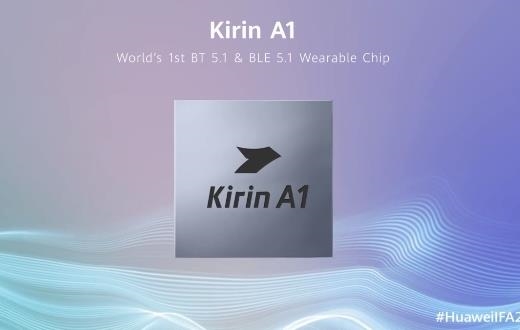

Samsung Display has acquired New York-based OLED microdisplay maker eMagin in an all-cash deal valued at approximately USD218M. The two firms expect this merger agreement to complete in 2H23. Founded in 1996, eMagin has expertise in the OLED microdisplay industry. Over the years, it has developed several industry-first microdisplay solutions, which are typically smaller than an inch and have an extremely high resolution or pixel density, as high as 2,600 PPI (pixels per inch). Smartphone displays typically have a pixel density of less than 500 PPI. The company has recently demonstrated the industry’s brightest WUXGA (1920×1200) full-color OLED microdisplay with a record-setting peak brightness of 15,000 nits.(Android Headlines, eMagin)
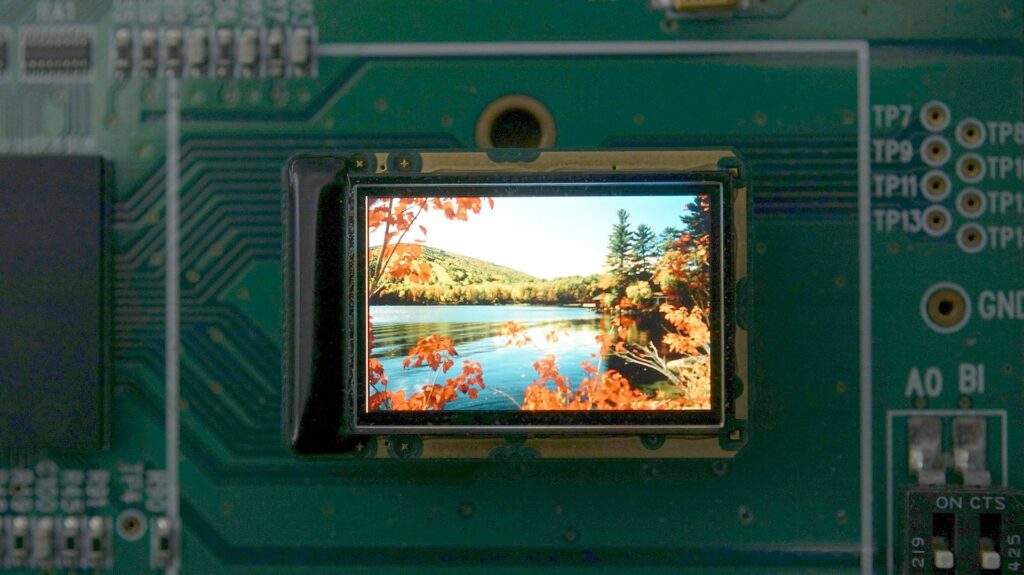
Apple is getting involved in the mass production of next-generation displays to lessen its reliance on rival Samsung and increase its own control over the supply of a key component. Apple has spent heavily on the development of micro-LED displays over the past decade and once production starts, it intends to perform the critical “mass transfer” step of the manufacturing process itself. The mass transfer step involves moving at least tens of thousands of tiny micro-LED chips onto substrates. This process will be carried out at Apple’s secretive R&D facilities in the Longtan District in the northern Taiwanese city of Taoyuan. Apple has reportedly spent at least USD1B on the R&D and samples for micro-LED technologies in the past nearly 10 years.(MacRumors, Asia Nikkei)
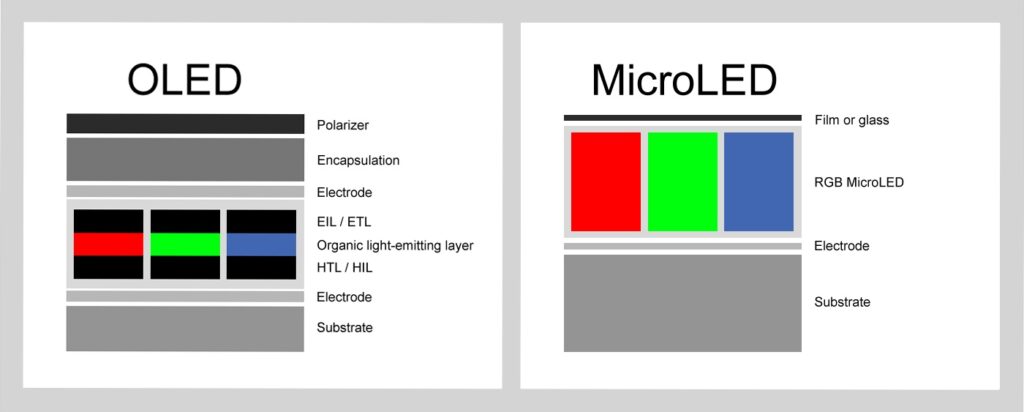
According to DSCC analyst Ross Young, foldable smartphone shipments were down YoY for the 2nd straight quarter in 1Q23 at 2.1M units. OPPO jumped to 2nd place with a 21% share. Samsung’s share fell to its 2nd lowest to date at 45%. The top 5 foldable models in 1Q23 were Samsung Galaxy Z Flip 5 at 27%, the Huawei Pocket S at 15%, Galaxy Z Fold 4 at 13%, OPPO Find N2 Flip at 11% and the Huawei Mate X3 at 6%. (Android Headlines, Twitter)
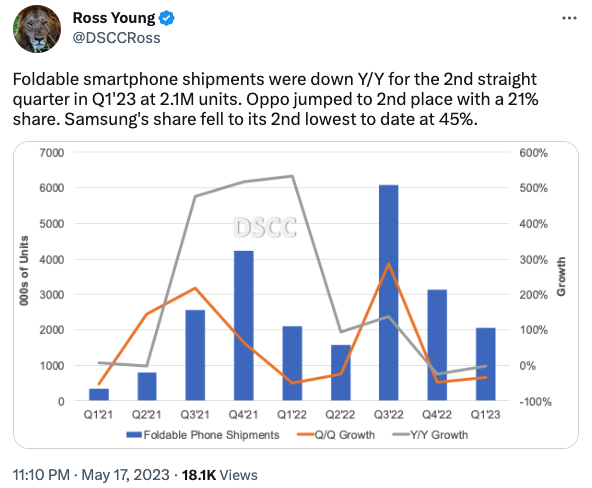
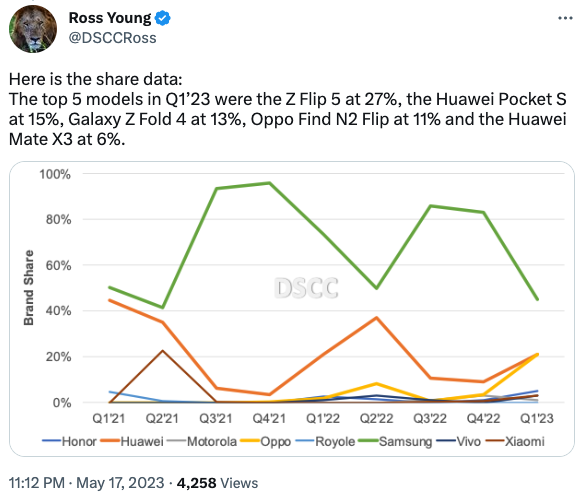

Apple’s lower-end iPhone 15 and iPhone 15 Plus models launching later in 2023 will be equipped with a 48Mp rear camera lens, according to Jeff Pu, an analyst at Hong Kong-based investment firm Haitong International Securities. Pu said the 48Mp lens on these models will use a new three-stacked sensor that can capture more light for improved image quality. However, based on recent supply chain checks, Pu believes the stacked sensor is likely facing yield issues that could result in iPhone 15 and iPhone 15 Plus production delays. The devices are still expected to launch in Sept 2023 as of now. (9to5Mac, MacRumors, CN Beta)

Sony has recently announced its Xperia 1 V and Xperia 10 V phones but it seems a successor to 2021’s Xperia Pro-I is also on the way, dubbed Xperia Pro-II. The main wide-angle camera sensor will yet again be of the 1” size. It is also rumored that Sony will use new sensors on all 3 cameras. The new smartphone will reportedly be launched in early 2024.(GSM Arena, Sumaho Digest, Android Headlines)
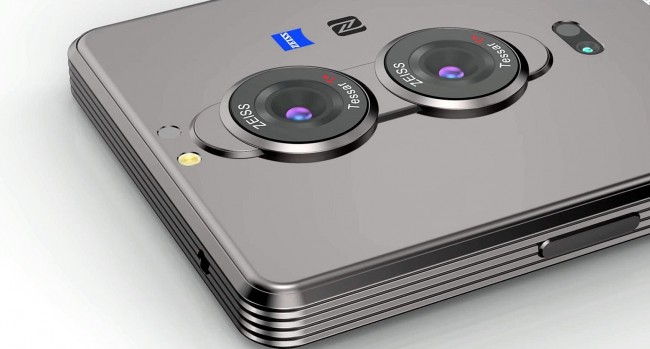
Hasselblad is reportedly joining Canon and Nikon in phasing out DSLRs. The entire Hasselblad H system lineup is officially discontinued. The move leaves Pentax and Ricoh as the biggest remaining names in the rapidly diminishing DSLR space. (Engadget, Capture Integration)
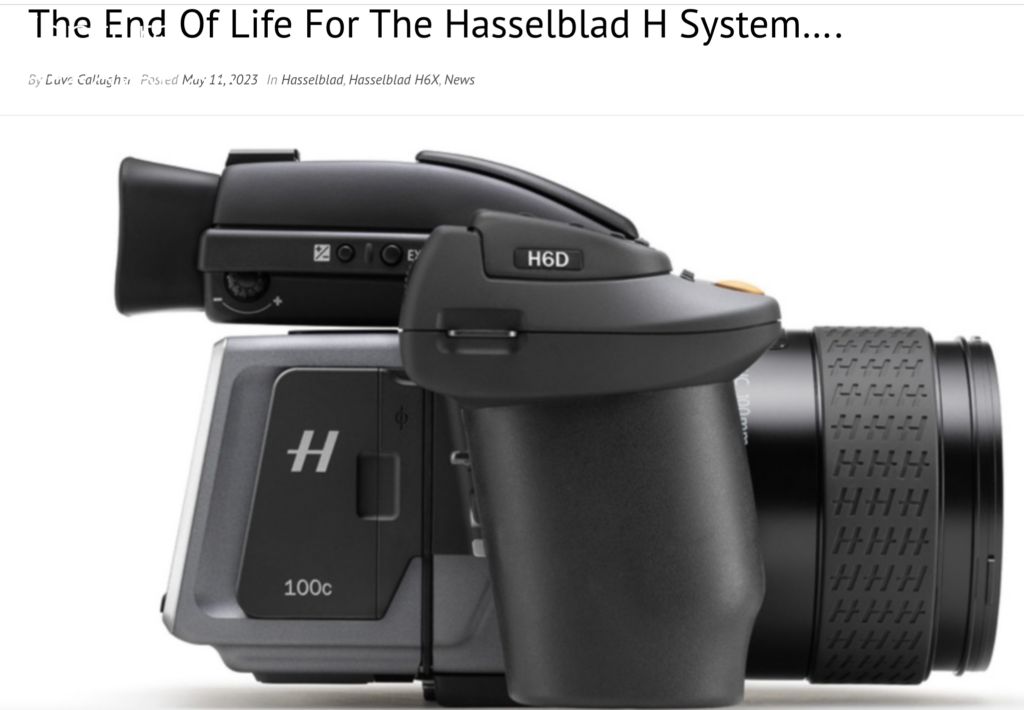
Samsung is testing a 2x option for the Galaxy S23 Ultra’s portrait mode. The 2x mode will use a 50MP crop from the 200MP main camera, which will then be brought down to 12MP. It joins the 1x and 3x options – the first using the main sensor, and the latter using the native 3x camera. Those are around 23mm and 70mm, adding a 2x with about a 50mm equivalent will result in more flattering portraits. The update is reportedly some 1.5GBs in size and is being finalized for release sometime by the end-May-early Jun 2023. (GSM Arena, Twitter)
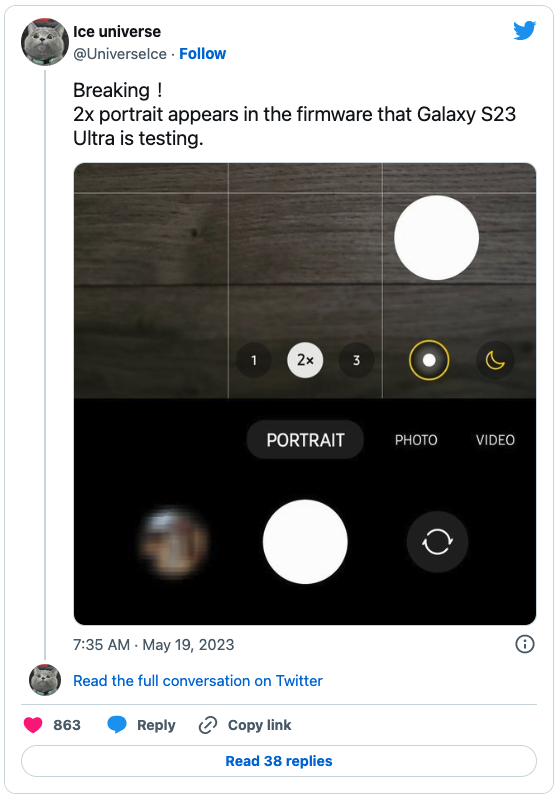

Google’s flagship Pixel smartphone series featuring the Pixel 8 and Pixel 8 Pro is expected to launch later in 2023. The Pixel 8 Pro will come with a built-in thermometer that can be used to measure body temperature. There is a dedicated infrared thermometer sensor that will be used to measure the temperature of body. This sensor is similar to what most contactless thermometers use.(Gizmo China, 91Mobiles, Twitter)
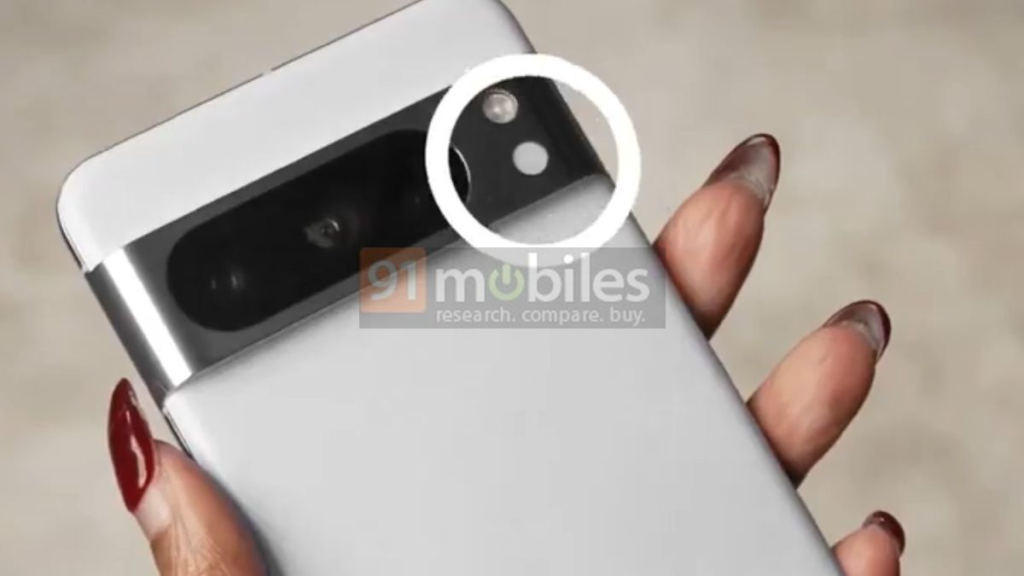

Micron has announced its 6500 ION NVMe and the XTR NVMe SSDs today, with both drives designed specifically for workloads and use cases that reside at opposite ends of the data center SSD spectrum. The Micron 6500 ION NVMe SSD is designed for ultra-high-capacity applications – it is only available at a 30.72TB capacity point – to deliver a cost-effective blend of performance and endurance through the use of leading-edge 232-layer TLC NAND. The 6500 ION is the first data center SSD to use 200+ layer flash, which Micron says delivers the economics of QLC flash, yet none of QLC’s other inherent drawbacks, like reduced performance and endurance. The ION’s performance is impressive, too, with up to 6.8 / 5 GB/s of sequential read/write throughput and up to 1 million / 200,000 random read IOPS. (CN Beta, Micron, AnandTech, Tom’s Hardware)
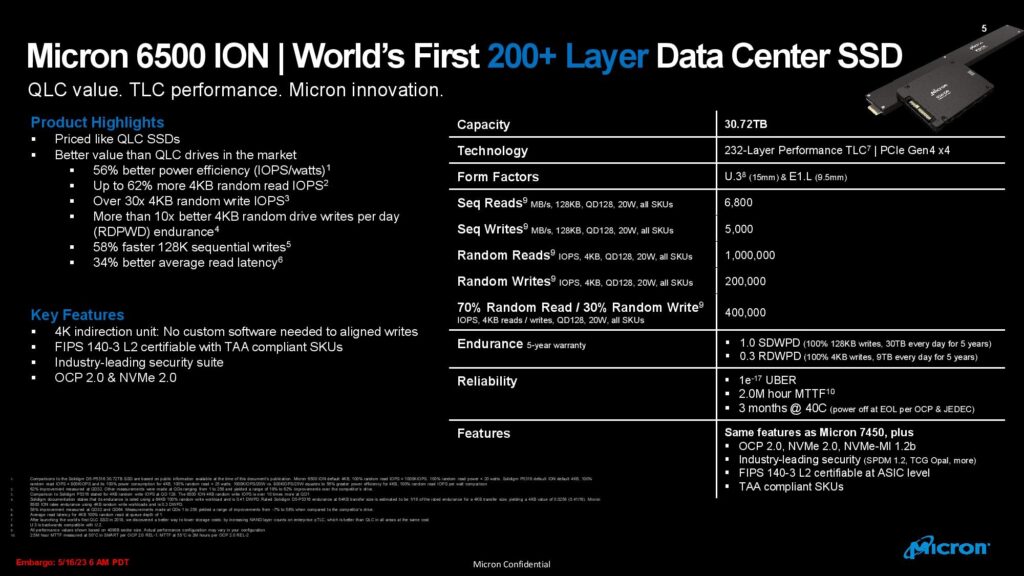
Micron has said it will invest JPY500B (USD3.6B) in 1-gamma process technology over the next f.ew years, with close support from the Japanese government. The investment would “enable the next wave of end-to-end technology innovation such as rapidly emerging generative artificial intelligence (AI) applications”. Micron added that it would be the first firm to bring extreme ultraviolet (EUV) chip-making to Japan. In providing support for Micron’s investment, Japan would tap some of the JPY450B in the budget earmarked for chip-related spending. Micron was expected to get about USD1.5B from Japan.(TechCrunch, Micron, Bloomberg, Japan Times)
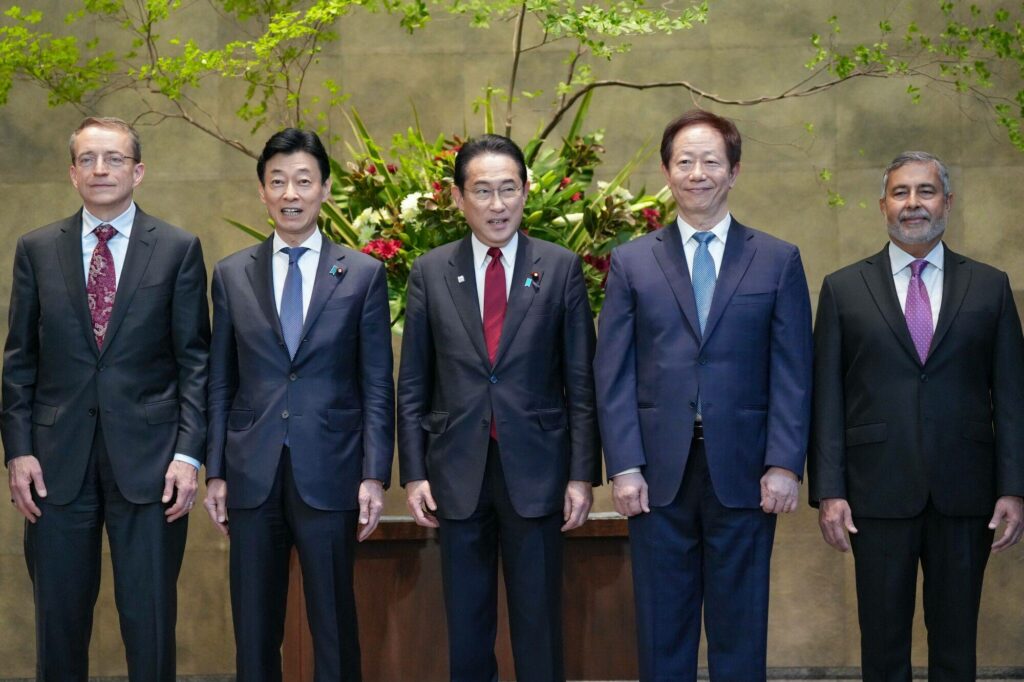
Samsung has announced that its 16-gigabit (Gb) DDR5 DRAM, which utilizes the industry’s most advanced 12nm-class process technology, has started mass production. Compared to the previous generation, Samsung’s new 12nm-class DDR5 DRAM reduces power consumption by up to 23% while enhancing wafer productivity by up to 20%. The DDR5 DRAM claims to deliver speeds of 7.2 gigabits per second (Gbps). To put this into perspective, it can process two 30-gigabyte (GB) ultra-high-definition movies in just one second.(Gizmo China, Samsung, CN Beta)
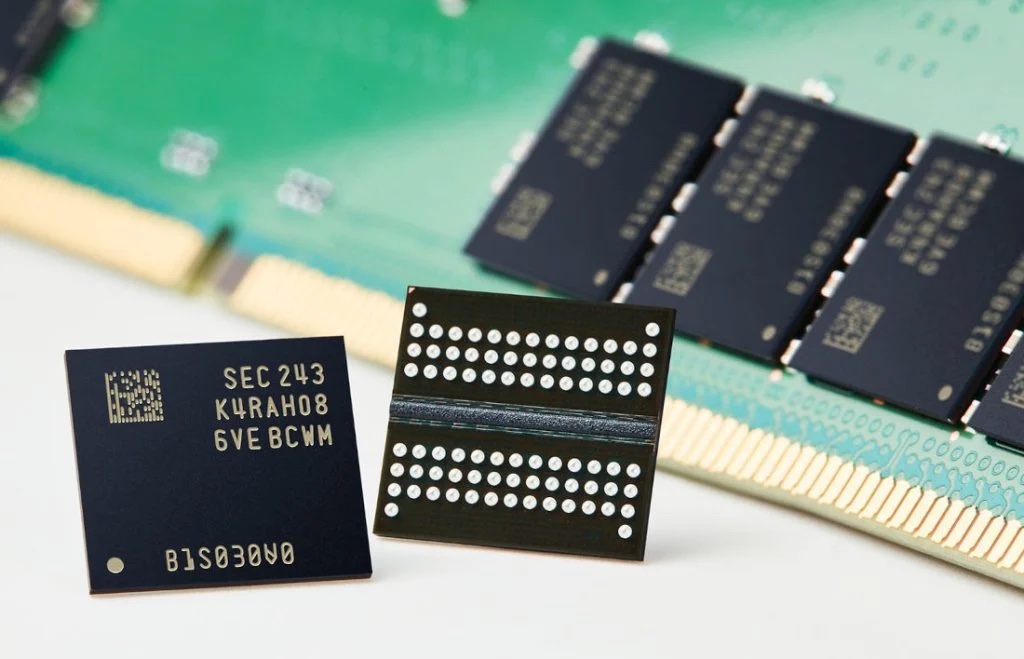

Vodafone has said it would cut 11,000 jobs over 3 years, as the telecom company unveiled a turnaround plan to revive its fortunes following years of poor performance. The job cuts would affect the firm’s UK headquarters and operations in other countries. The company, which has businesses in 21 countries and partnership agreements with local operators in another 46 locations, has struggled to retain market share. Vodafone employs 104,000 people worldwide. (CN Beta, Reuters, BBC, CNN, Vodafone)

OPPO’s German website has removed all information pertaining to its products. The company’s operations in the country are currently on hold as a result of a patent lawsuit filed by Nokia. OPPO was also previously rumored to have stopped selling new devices in France. The site’s homepage currently only highlights OPPO’s partnership with the UEFA Champions League.(Android Central, OPPO.de, CN Beta, GSM Arena)

Foxconn will invest USD500M to set up manufacturing plants in the southern Indian state of Telangana. Telangana industries and IT minister KT Rama Rao has laid foundation stone for new electronics manufacturing unit of Foxconn Interconnect Technology at Kongara Kalan in Hyderabad. The new facility is a promise to continue delivering world-class products to the markets, and a milestone for Foxconn Interconnect Technology’s global expansion strategy – diversifying its global manufacturing base. (CN Beta, Hindustan Times, India Times, TechCrunch)

Kyocera is restructuring its consumer strategy in Japan to more closely align with its business-first strategy in North America. According to Vipul Dalal, VP of the Communications Equipment Group at Kyocera International, Kyocera refocused its North American wireless phone market strategy to emphasize business solutions several years ago, and their Japan-based parent company is now doing the same in the Japanese market. The rugged durability of a Kyocera smartphone remains attractive to many consumers, and consumers can continue to purchase their smartphones as they always have – through carriers such as Verizon, both in-store and online, and through the Kyocera website. (Android Authority, Android Headlines, Nikkei)
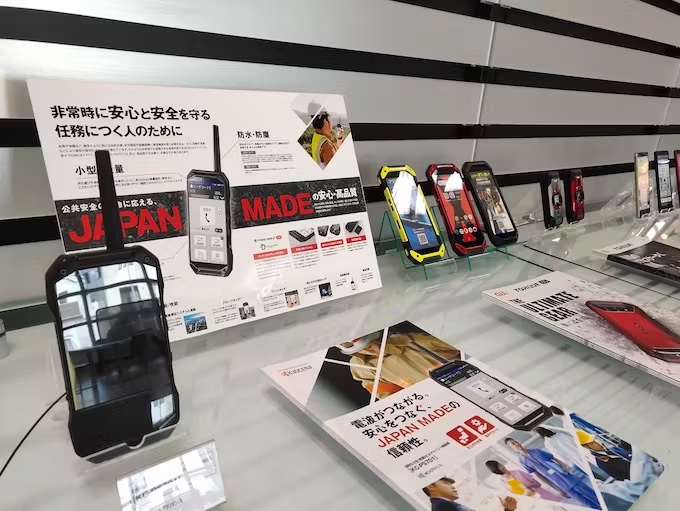
Since its establishment in 2008, Apple’s App Store has garnered a substantial following with over 650M weekly visitors from across the globe. It has also become a platform with over 36M registered Apple developers contributing apps, supporting over 195 local payment methods and accommodating transactions in 44 currencies. The company has announced that in 2022, the App Store successfully intercepted and prevented potential fraudulent transactions worth over USD2B. Furthermore, Apple rejected close to 1.7M app submissions due to their failure to meet the App Store’s privacy, security, and content rules. That includes credit card fraud, and in 2022 Apple says it blocked nearly 3.9M stolen credit cards from being used for fraudulent purchases. It also banned 714,000 accounts from transacting again. (Apple Insider, Apple.com)
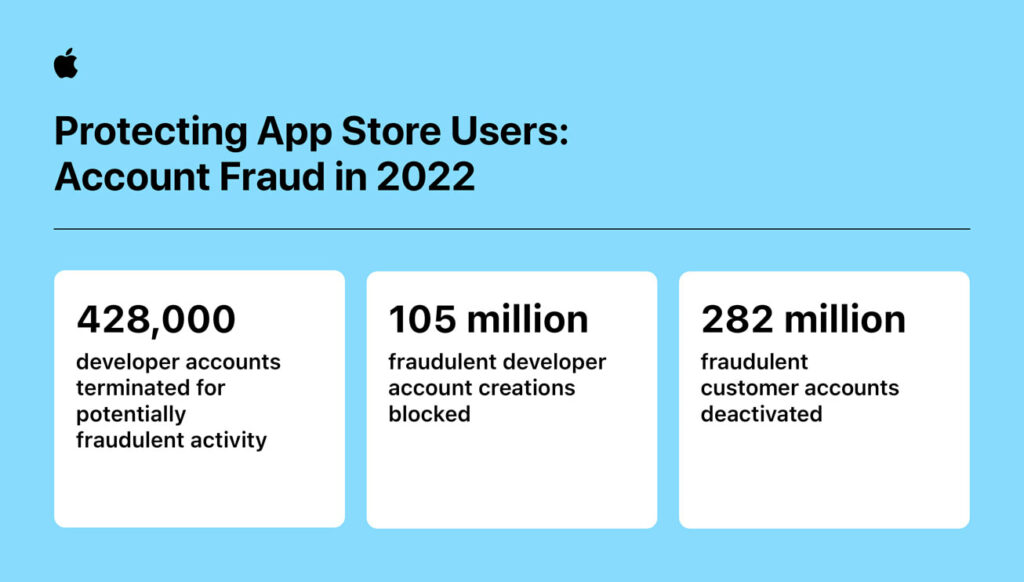
Google has announced it will start deleting accounts that have been inactive for at least 2 years, a move that the company says is intended to prevent security risks. The updated policy takes effect immediately, but Google said it will not begin deleting accounts until Dec 2023. The company plans to send out multiple warning notifications to users and to conduct the purge of inactive accounts in phases.(Engadget, Google, CNN, Reuters, Ars Technica)
Samsung Electronics will reportedly not change the default search engine on its smartphones from Google to Microsoft’s Bing any time soon. Samsung has suspended an internal review that explored replacing Google with Bing on its web-browsing app, which comes pre-installed on the company’s smartphones. (Android Authority, Reuters, WSJ)
Nothing’s next phone is expected to have a global launch, including in the United States. The company has hired Kyle Kiang as VP of North America, where he will lead the phone’s global launch. Also, a new report claims that 70% of the software team from Nothing comprises people from OnePlus.(Inverse, Android Central)
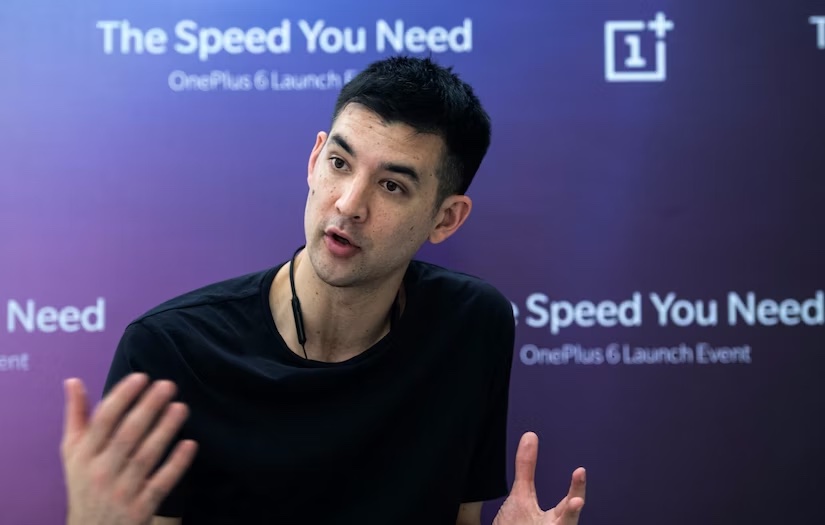
According to TF Securities analyst Ming-Chi Kuo, Apple is expected to help Luxshare set up production lines in India, and Luxshare will benefit from the growth of the Indian market and supply chain in the coming years. Luxshare has obtained the NPI for the highest-end iPhone 16 model (Pro Max) in 2024. This is the first time that Foxconn does not win the highest-level iPhone assembly NPI. Luxshare’s iPhone business will see significant profit growth from 2H23. Luxshare expects to ship 45–50M iPhones in 2023 (up from approximately 20M in 2022), with the iPhone 15 Plus NPI already secured and the 15 and 15 Pro Max as a second supply. (MacRumors, Medium, Twitter)
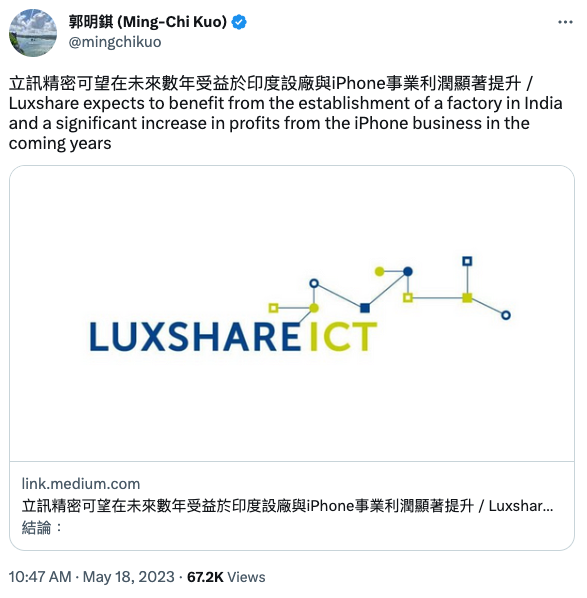
Google’s Pixel roadmap in 2024 is leaked: Pixel 8a (codename “akita”), yet Google is thinking about moving away from annual launches of A series phones and instead going for a biennial launch (every 2 years); Pixel 9 series to be launched in 2024 fall – Pixel 9 Pro (codename “komodo”) with 6.7” display, 2nd Pro (codename “caiman”) with 6.3” display. Pixel 9 series to feature Google Tensor G4, codenamed “redondo”. For 2025, Google is looking at several choices for its Pixel roadmap, which will be heavily influenced by the success or failure of its 2023 and 2024 plans. Google is toying with the idea of having a flip-style foldable phone to compete with the Galaxy Z Flip series, to be launched in fall 2025. However, if Google abandons the flip-style device, it would move ahead with four non-folding phones. That would be a vanilla model in small and large sizes and a pro model in small and large sizes.(Android Authority, Reporter Byte, CNET)
According to data from Statista, Google’s growing number of Pixel owners are also the most likely to consider switching to other brands on their next upgrade, creating a problem for brand loyalty. A whopping 57% of Google Pixel owners surveyed said they are very likely to switch to a different smartphone brand at the “next possible occasion.” A mere 26% were “very unlikely” to switch. In the survey, a mere 442 Pixel owners were surveyed, where the survey asked for input from nearly 3,000 Galaxy owners and over 4,400 iPhone owners. (Android Headlines, 9to5Google, Statista)
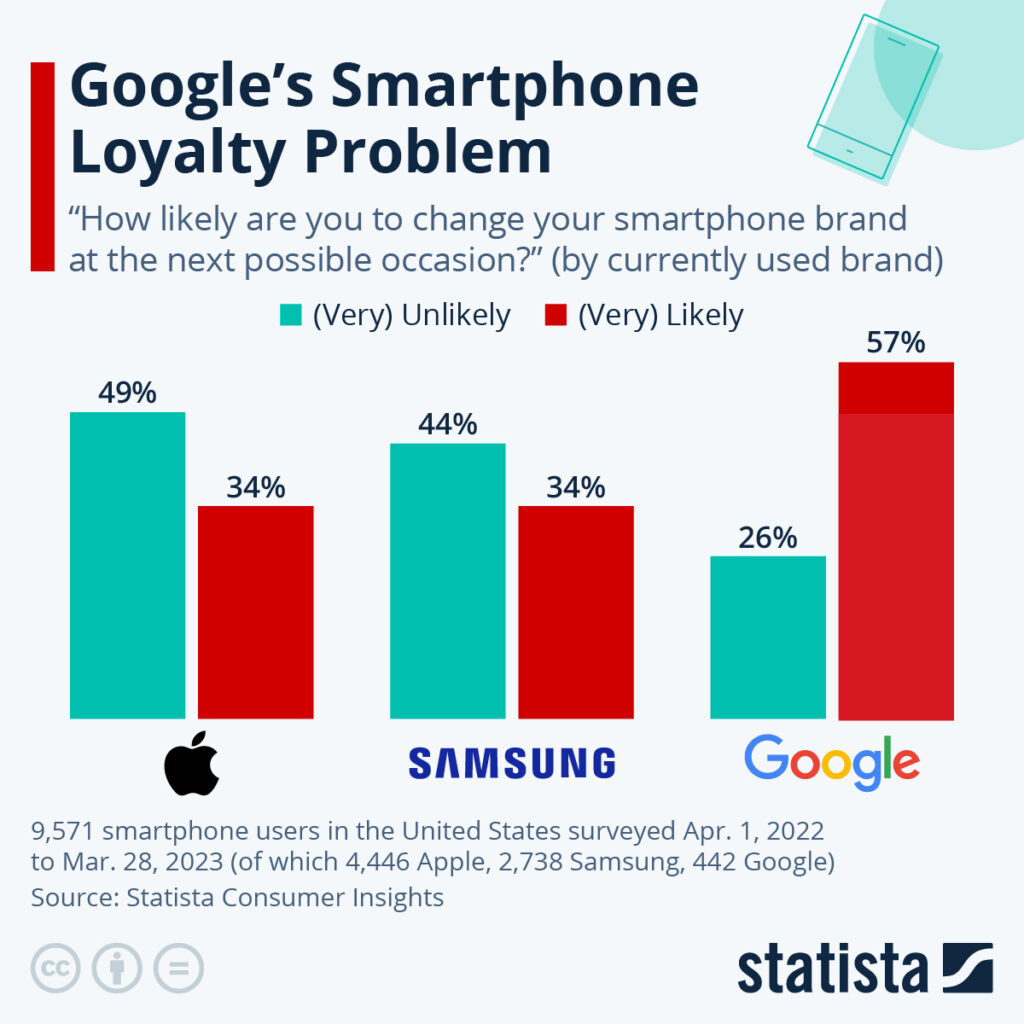

Samsung is allegedly working on a new device, dubbed DeXbook, that combines Samsung DeX and Google ChromeOS. DeX is a platform that allows users to connect their Samsung Galaxy smartphones and tablets to a monitor or TV to create a desktop-like experience. When connected to a larger display, DeX expands the phone’s screen and provides access to a full-size keyboard and mouse. ChromeOS on the other hand is a lightweight operating system that is designed for Chromebooks, which are typically budget-friendly laptops. DeXbook is said to be powered by an Exynos chip and could be announced alongside a new Exynos-powered Galaxy Book for Windows on Arm. (Gizmo China, SamMobile)
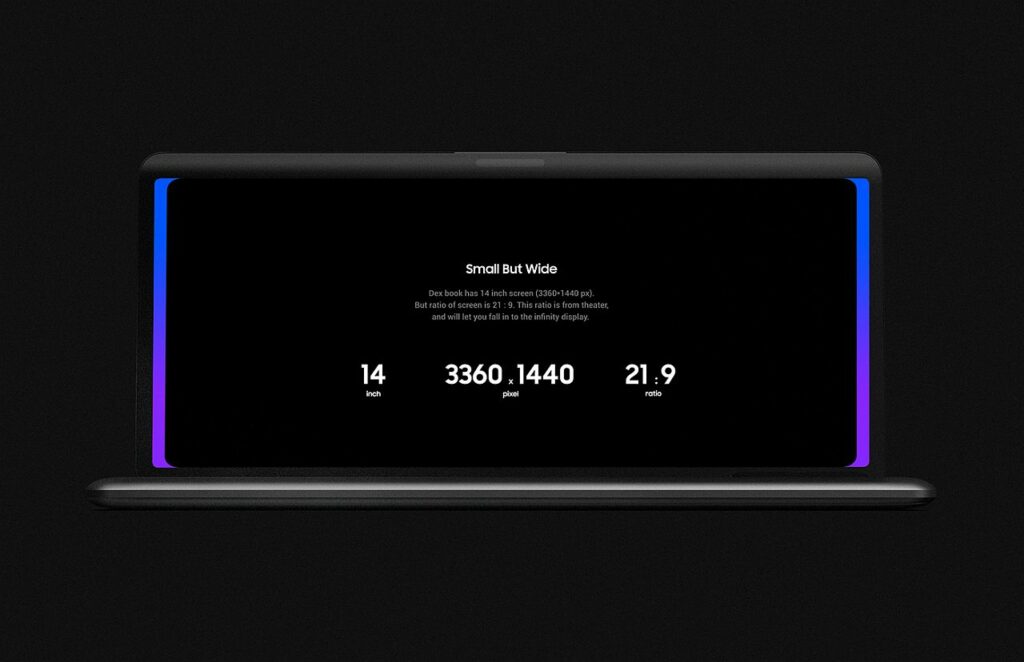

Samsung has announced that it will be upgrading the Ambient Sound feature on the Galaxy Buds 2 Pro. Previously, the feature offered 3 levels of customization. The new enhanced version of Ambient Sound will add 2 additional levels of amplification. According to Samsung, the University of Iowa’s Hearing Aid and Aging Research Laboratory held a clinical trial for the feature to test its efficacy. Samsung has also announced an Adapt Ambient Sound feature that will allow users to better tune the level of clarity to their ears. (Engadget, Android Authority, Samsung)
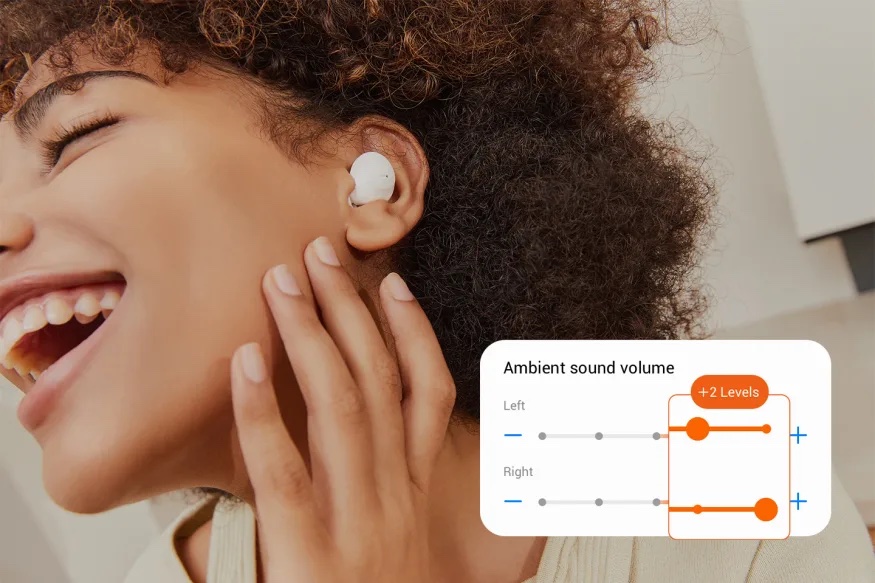

According to TF Securities analyst Ming-Chi Kuo, Apple announcing AR/MR headset at WWDC bodes well for supply chain share price. Apart from the assembly (exclusive to Luxshare-ICT), micro OLED display (exclusive to Sony), dual processors (exclusive to TSMC), casing (Everwin Precision as the main supplier), 12 camera modules (exclusive to Cowell), and external power supply (exclusive to Goretek) are the top 5 most expensive material costs for this new device. Cowell is the largest beneficiary in terms of revenue and profit contribution to suppliers due to its smallest revenue size. The headset device will soon become the most important new investment trend in the consumer electronics sector if Apple’s AR/MR headset announcement is better than expected. (GSM Arena, Medium, Twitter)
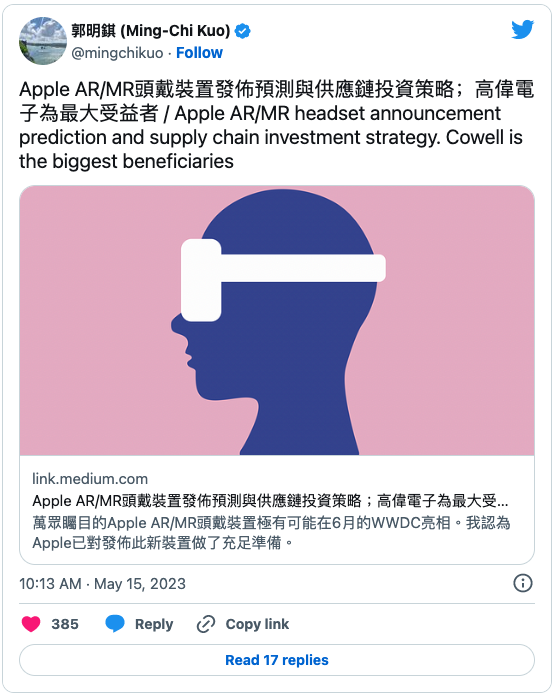

German car maker Volkswagen has reportedly held talks to use Huawei software in its cars in China, hoping to boost flagging efforts to claim a bigger share of the world’s biggest EV market. VW’s own software operation, Cariad, has been beset by problems since its creation in 2020, including budget misses and delays that led to hold-ups in the launch of new electric vehicles such as Audi’s Q6 e-tron and Porsche’s Macan. In a bid to gain ground in China’s EV market, the German group recently set out an “in China, for China” strategy and has in recent years announced billions of euros’ worth of investment in areas including autonomous vehicles. VW’s battery firm PowerCo will seek Asian partners to build 3 new battery plants in the next 10 years, to help realize the parent company’s goal of going all-electric, said Sebastian Wolf, chief operating officer of PowerCo. (GSM Arena, Financial Times, Business Insider, Ijiwei)
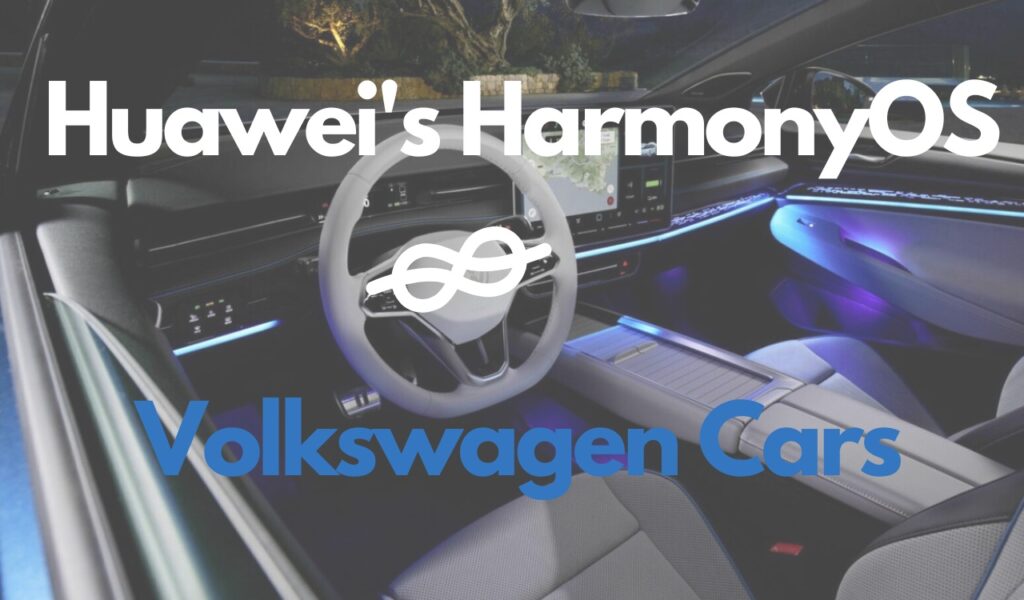
Jay Y. Lee, executive chairman of Samsung Electronics, has met with Tesla CEO Elon Musk for the first time to discuss measures to expand cooperation between the two companies in future industry areas, especially on semiconductors for self-driving cars. Samsung and Tesla have had cooperation since 2019, as Samsung Foundry has been supplying full self-driving chips to Tesla. Currently, Samsung produces advanced autonomous-driving chips for Nvidia and Mobileye. Samsung has recently bolstered its technology leadership in the foundry sector by introducing the 4-nanometer production process to grow its autonomous vehicle business.(Gizmo China, Reuters, Pulse News, Korea Herald, Korea IT Times)
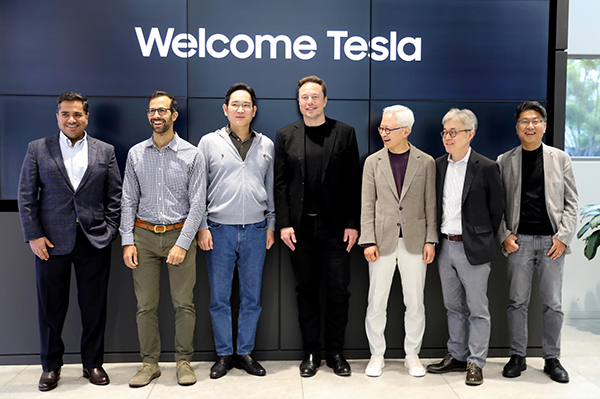

Samsung Electronics and Naver have agreed to jointly develop a generative artificial intelligence platform for corporate users to compete with global AI tools such as ChatGPT. Under their AI partnership, Naver, the country’s top online and search engine operator, will receive data related to semiconductors from Samsung to create a generative AI, which will then be further enhanced by Samsung. Once developed, the AI tool, available in Korean, will be used by Samsung’s Device Solutions (DS) division, which includes its semiconductor business. The two partners aim to unveil the AI tool as early as Oct 2023.(Android Headlines, KED Global)
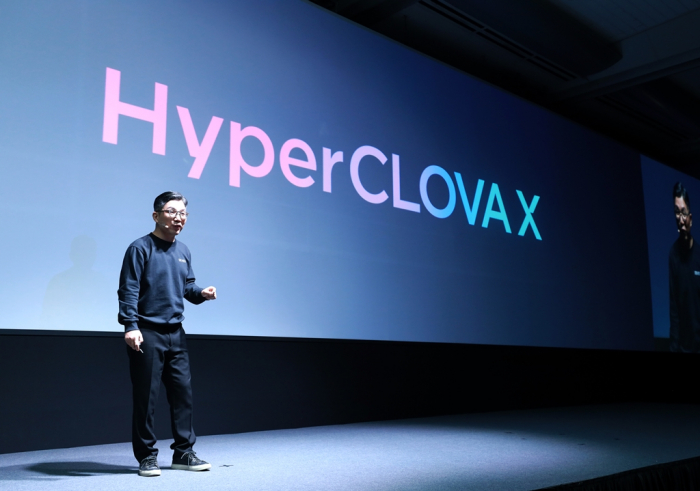
OpenAI has officially launched standalone ChatGPT app for Apple iOS users and it is free to download and use. For instance, the app supports voice input powered by the company’s open-source speech recognition model Whisper. It also synchronizes chat history from the web version of ChatGPT and other devices with account logged in. ChatGPT Plus subscribers gain access to the upgraded GPT-4 version, early access to new features that may come in the future and quicker response times.(GSM Arena, Apple)
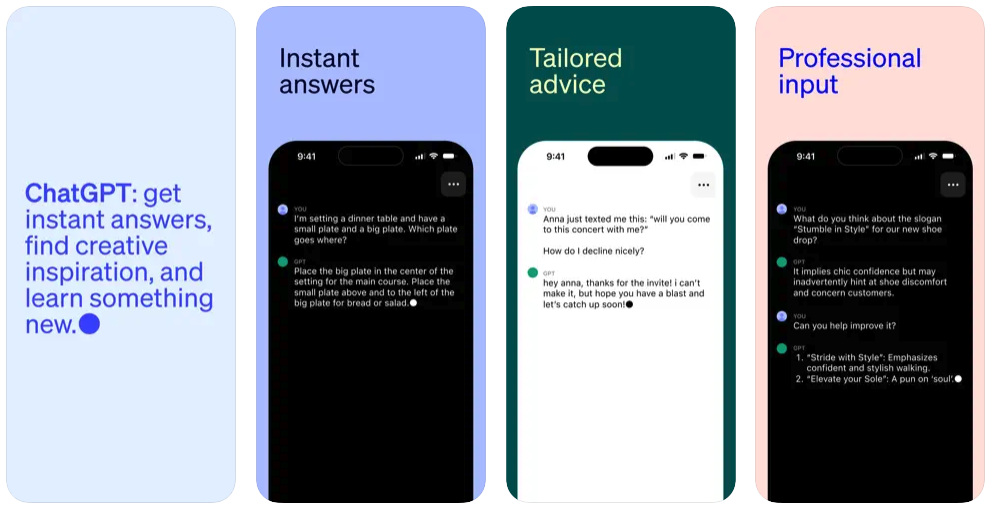
Apple has allegedly restricted internal use of tools like OpenAI’s ChatGPT and Microsoft-owned GitHub’s Copilot. Apple is worried about its confidential data ending up with developers who trained the models on user data. In May 2023, Samsung also banned employees from using generative AI tools like ChatGPT after reportedly registering three separate incidents of them feeding proprietary company data to the chatbot. (GizChina, TechCrunch, WSJ)
